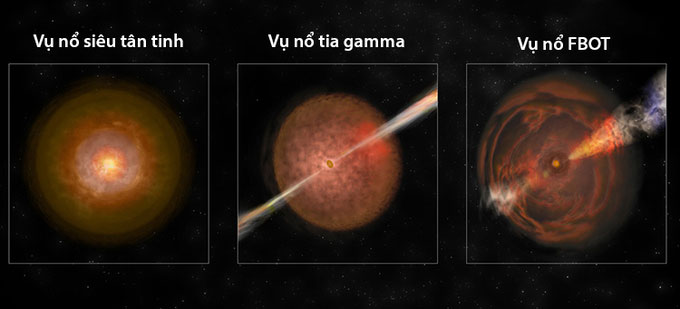Discover a new kind of explosion in the universe
Astronomers on Thursday said they have discovered a new type of stellar explosion, different from the gamma-ray and supernova explosion.
The event, dubbed FBOT , means an instant explosion that releases a pulse of blue light that lasts for a very short time, caused by an extremely intense astrophysical process that has so far been unknown. Well understood by scientists.
FBOT may have started out like a gamma-ray and supernova explosion - which occurs when a massive star consumes the energy of nuclear fusion and dies - but the difference is apparent in Later stages of the explosion, the team explained.

Graphics simulating three types of star explosions in the universe. (Photo: Bill Saxton).
In a conventional supernova event, also known as a core collapse supernova, the explosion will release a wave of spherical matter into space. If around a neutron star or black hole (formed after the explosion) there is a accretion disk and pushes the material rays to both sides, the event is called a gamma ray burst.
FBOT also has such a accretion disk and material rays, but the difference is that they are surrounded by dense matter. This material layer may have been ejected by the star just before exploding, or pulled out by another star in the binary.
When the material layer is hit by energy waves from the explosion, it creates another explosion of light visible to the naked eye, which is what makes FBOT different.
Astronomers have started paying attention to FBOT since June 2018 after observing an unusual explosion called AT2018cow in the constellation Vu Tien. During the study, they discovered two more similar explosions - CSS161010 and ZTF18abvkwla - respectively 500 million years and 3.4 billion light-years from Earth. Both were detected by automated sky survey telescopes.
By observations from the giant Metrewave Radio Telescope, Very Large Array and NASA Chandra X-ray Observatory, the team said that radio emissions from ZTF18abvkwla were as bright as a gamma ray burst. , while CSS161010 releases a large amount of matter into space at approximately half the speed of light.
Along with AT2018cow, only three FBOT explosions have been recorded so far. All are located in dwarf galaxies, astronomers said. Details of the study have been published in the Astrophysical Journal.
- Discover the largest explosion ever seen in the universe
- Detecting a strange explosion in a distant galaxy
- The most powerful explosion in the universe after Big Bang
- Identify the universe
- Discover an unusual new explosion in the universe
- We live in the end of the universe
- Spectacular picture of the Big Bang
- Spectacular supernova explosions in the universe
- The forgotten model of Einstein predicts the end of the universe
- Stunned the unexpected stories before the Big Bang
- Development of the universe model before the Bigbang explosion
- The universe will have the largest ever explosion of two black holes
 Van Allen's belt and evidence that the Apollo 11 mission to the Moon was myth
Van Allen's belt and evidence that the Apollo 11 mission to the Moon was myth The levels of civilization in the universe (Kardashev scale)
The levels of civilization in the universe (Kardashev scale) Today Mars, the sun and the Earth are aligned
Today Mars, the sun and the Earth are aligned The Amazon owner announced a secret plan to build a space base for thousands of people
The Amazon owner announced a secret plan to build a space base for thousands of people